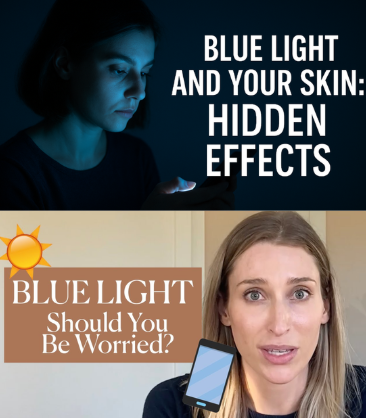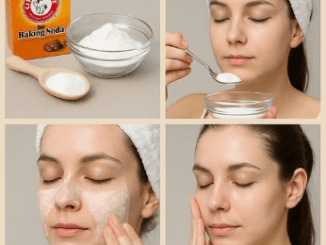
In today’s hyper-digital world, blue light has become an invisible companion. Whether you’re scrolling through your phone late at night, binge-watching your favorite series, or working under LED lighting, your skin is constantly exposed to this high-energy visible (HEV) light. While a little natural blue light from the sun can boost mood, focus, and alertness, excessive exposure—especially from screens held close to your face—can have negative effects on your skin. Let’s break down how blue light impacts your complexion and, more importantly, how to protect yourself.
Understanding Blue Light and Where It Comes From
Blue light is a segment of the visible light spectrum, positioned just next to ultraviolet (UV) rays. It carries more energy than red or yellow light, which means it penetrates deeper into your skin. While the sun is still the main source of blue light, digital devices like smartphones, tablets, laptops, and televisions add extra daily exposure. The key difference is proximity. Unlike the sun, our devices sit just inches away from our skin, making their impact more concentrated.
Think of it like sitting by a campfire. The closer you are, the more heat you feel. Similarly, holding your phone close to your face intensifies blue light exposure.
The Hidden Effects of Blue Light on the Skin
The impacts of blue light go far beyond eye strain or disrupted sleep. Research has shown that it can leave a lasting mark on your skin.
- Hyperpigmentation and dark spots: Blue light exposure has been linked to more pronounced pigmentation than UVA rays in the same time frame. This means freckles, spots, and uneven tone may appear more quickly.
- Premature aging: Blue light stimulates free radical production, which damages skin cells, breaks down collagen, and accelerates wrinkles and fine lines.
- Inflammation and redness: Some people notice increased swelling, redness, and skin sensitivity after heavy exposure.
- DNA damage: Over time, continuous exposure may contribute to deeper structural harm in the skin, speeding up the natural aging process.
In short, blue light is like a slow leak in a tire. You may not notice the damage immediately, but over time, your skin pays the price.
Video : Do You Need to Worry About Blue Light? A Dermatologists Explains How it Affects Your Skin
Blue Light and Photo-Aging
The term photo-aging is usually associated with sun damage, but blue light deserves a place in this conversation. Photo-aging from HEV light shows up as fine lines, sagging skin, hyperpigmentation, and a dull complexion. Essentially, your skin begins to look older before its time. Unlike sunburn caused by UVB rays, blue light works quietly beneath the surface, gradually weakening your skin’s defenses.
Why Digital Devices Pose a Unique Threat
Although your phone emits less blue light than the sun, two factors make it risky: closeness and constant exposure. You’re likely staring at your phone, laptop, or TV for hours each day, giving blue light endless opportunities to harm your skin. Add to that the fact that your devices may carry more bacteria than a toilet seat, and it’s clear that your gadgets aren’t exactly skin-friendly companions.
How to Protect Your Skin from Blue Light Damage
You may not be able to ditch your devices entirely—work, social connections, and entertainment make them nearly unavoidable—but you can take smart steps to minimize harm.
Turn on Night Mode or Reduce Brightness
Most devices today come with built-in “night mode” or blue light filters. Turning these on reduces exposure instantly. Even lowering the screen brightness helps minimize the intensity of the light hitting your skin.
Wear Protective Skincare
Even though blue light doesn’t burn your skin like UV rays, it still contributes to aging. Applying sunscreen with broad-spectrum coverage and antioxidants can neutralize free radicals. Lightweight moisturizers with ingredients like niacinamide, vitamin C, or green tea extract also help fortify your skin against oxidative stress.
Limit Screen Time Before Bed
Your skin and eyes both need recovery time. Avoiding digital devices at least an hour before bed not only helps your sleep cycle but also gives your skin a break. Instead of doom-scrolling, try reading a book, journaling, or chatting with family. Your skin will thank you.
Follow the 20-20-20 Rule
To protect both your eyes and skin, practice the triple twenty method: after every 20 minutes of screen use, look at something 20 feet away for 20 seconds. This short break reduces strain and gives your body time to recover.
Consider Blue Light Blocking Tools
From screen protectors to specialized glasses, there are many tools available to filter blue light. Some beauty brands now even offer “anti-blue light” foundations, primers, and serums designed to shield your skin throughout the day.
Lifestyle Habits That Strengthen Your Skin’s Defense
Beyond gadgets and skincare products, your overall lifestyle can help your skin resist damage.
- Hydrate well to keep skin plump and resilient.
- Eat antioxidant-rich foods like berries, leafy greens, nuts, and fish to fight free radicals.
- Sleep adequately so your skin has time to repair overnight.
- Clean your devices regularly to minimize bacteria that transfer from screens to skin.
Think of your skin as armor—it stays strongest when supported by both internal nutrition and external protection.
Video : Effect of Blue Light on skin | Dr Jyoti Gupta MD
Conclusion
Blue light may not seem as threatening as UV rays, but its subtle, long-term effects on the skin are real. From pigmentation and premature aging to inflammation and DNA damage, consistent exposure leaves your complexion vulnerable. Fortunately, you don’t have to abandon your devices—just adopt smarter habits. Reduce brightness, apply protective skincare, take screen breaks, and live a lifestyle rich in antioxidants. By making these small but powerful changes, you can shield your skin from blue light and keep it youthful, healthy, and glowing.


